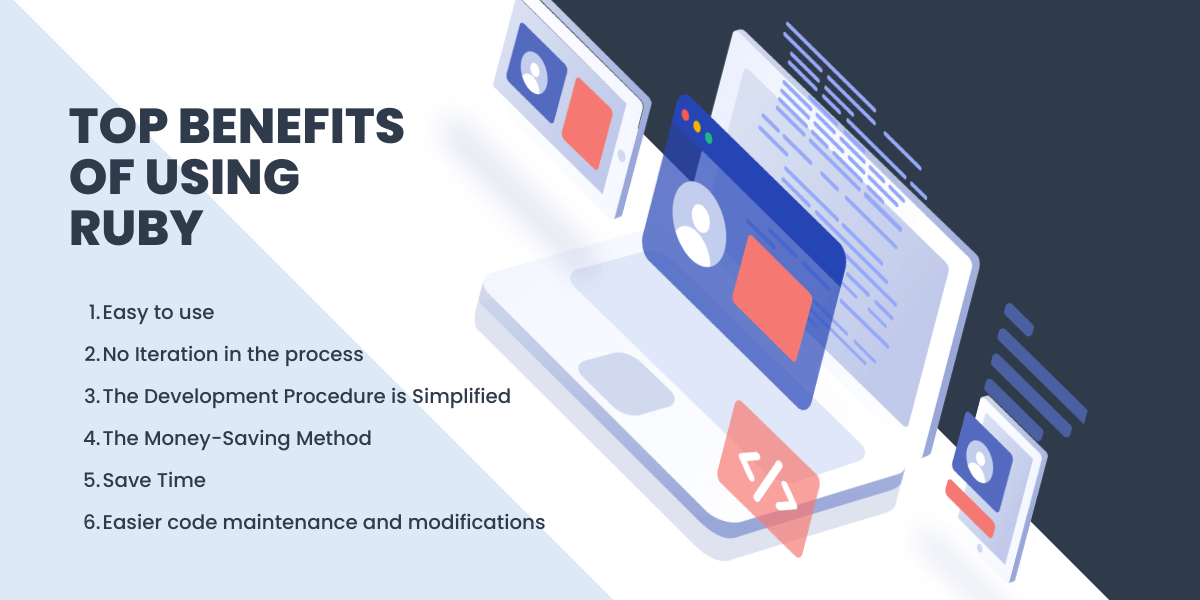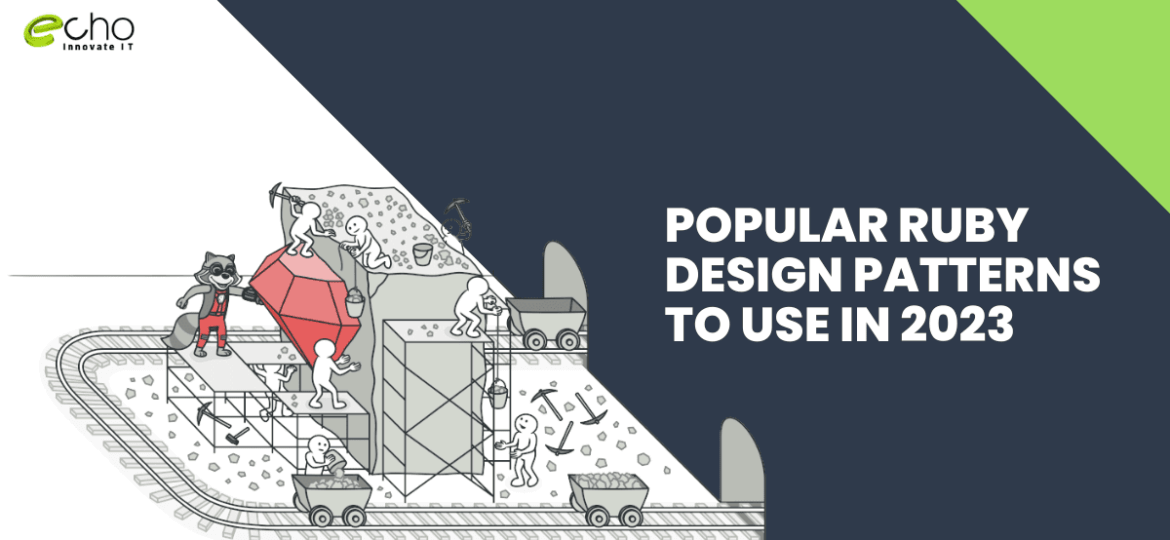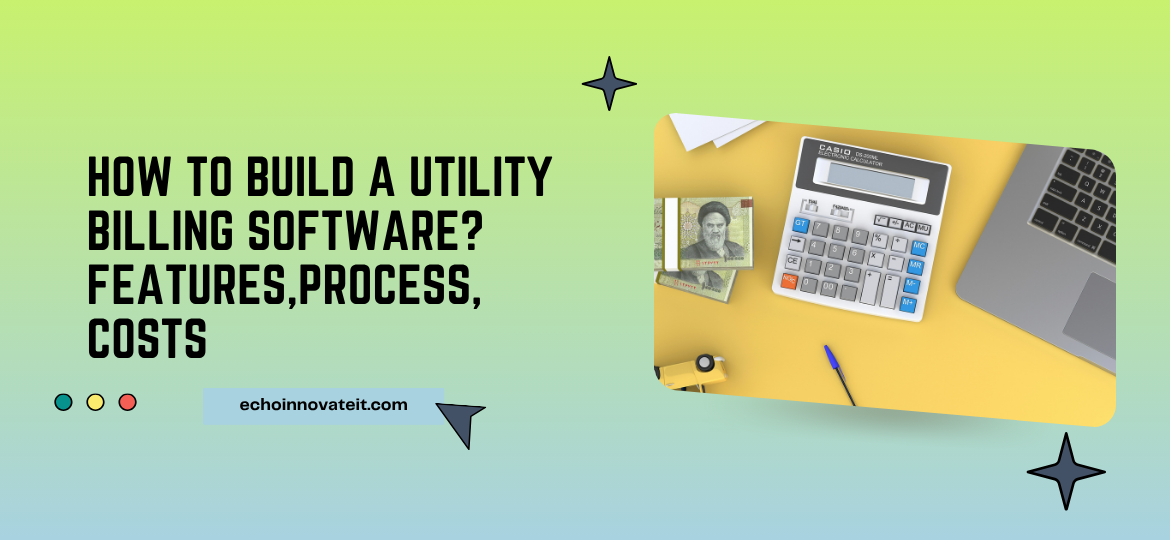All of us must have heard about Ruby Design patterns. The Ruby programming language is widely used for creating dynamic, object-oriented, and reflective web applications and is freely available to the public. When Ruby first appeared, it was 1995.
Twitter, Airbnb, GitHub, Slideshare, Basecamp, and Twitch are just a few of the hundreds of apps developed using this language since then. Ruby’s appreciation comes from the fact that dedicated Ruby developers can produce more with less coding because of its simple but extensive syntax.
For the time being, Ruby is the world’s 15th most crucial programming language according to the TIOBE index and the 16th most important according to the PYPL ranking. Ruby’s attractiveness to start-ups and low-budget businesses stems partly from the fact that it’s free.
Some frameworks are designed to simplify the application’s middleware and request/response, while others are explicitly tailored to REST APIs or web development. This essay will discuss many of the most notable Ruby frameworks, which have been compiled worldwide.
What Are Design Patterns?

A pattern is a solution to a common issue in software engineering that may be utilized repeatedly. The design represents a best practice in the field of software engineering. Patterns have their anti-pattern counterparts in software engineering, but more later.
A design pattern is a collection of guidelines for creating efficient, readable Code. Design patterns like this make it easier for other developers to comprehend the system’s operational logic. Ruby design patterns are substantial chunks of Code that minimize complexity by integrating principles and best practices. Business logic and algorithms may be transmitted via design patterns.
Some Considerations For Using Design Patterns
The following are some of the architectural improvements that may be made with the proper use of ruby design patterns:
- The software development process may be accelerated using well-designed and proven patterns.
- In addition to minimizing the number of problems that aren't evident at an early stage of development, design patterns also aid in avoiding problems that may become more apparent in the future.
- Without design patterns, adding new features or supporting additional use cases in the Code is harder.
- Code that documents itself and is easy to understand may be achieved by following some basic architectural guidelines. It will be easier for developers outside the creative process to adhere to the guidelines.
Top 10 Ruby Design Patterns

Let’s go through each of the available Rail design patterns and how to put them to use.
Service Objects
Plain Old Ruby Objects, or Service Objects, are used to break down large computations and other business logic into more manageable classes and methods. This is a typical design pattern in the Ruby on Rails framework.
Places where service objects can be used:
Plain Old Ruby Objects, or Service Objects, are used to break down large computations and other business logic into more manageable classes and methods. This is a typical design pattern in the Ruby on Rails framework.
- When complicated computations or business logic are required, for instance, determining an employee's pay depending on their attendance.
- A payment gateway, like Stripe, must be set up before any other API can be implemented.
- When we need to bring in a big CSV file with data, like a database. There will be no impact on pre-existing data when we purge the database of obsolete, redundant, or otherwise useless information.
View Objects (Presenter)
Rails View Objects let us encapsulate any functionality related to views, which helps maintain order in our models and theories. View objects are an excellent example of a testable Rails pattern since they are just classes. We can utilize a Rails helper to handle the calculating logic, but if the Code is too complicated, we should switch to the Presenter instead.
Query Object
Query Objects allow us to modularize and re-use our query code without requiring changes to our Controllers or Models. As its name suggests, query object classes partition the reasoning behind database queries.
Decorators
Rails decorator is another typical ruby design pattern in rails. Decorators are a design pattern that lets new behaviors be dynamically added to objects without affecting how other instances of that class act. Decorators are a powerful tool for organizing the view and controller code in a Ruby on Rails application.
To extend an object’s capabilities, the Decorator pattern wraps it in a second object that contains expanded functionality. This is useful for adding new functionality to an existing class instance without declaring new static subclasses.
Decorators
Rails decorator is another typical ruby design pattern in rails. Decorators are a design pattern that lets new behaviors be dynamically added to objects without affecting how other instances of that class act. Decorators are a powerful tool for organizing the view and controller code in a Ruby on Rails application.
To extend an object’s capabilities, the Decorator pattern wraps it in a second object that contains expanded functionality. This is useful for adding new functionality to an existing class instance without declaring new static subclasses.
Value Object
Small, straightforward objects are promoted by the Ruby pattern known as the Value object, which also facilitates comparisons between objects using the specified logic or a set of characteristics. It’s a value representation, but it’s not a user object, which is something unique to your system. Whenever you ask for a result from a Value Object, you will only get a value back.
Observer
This pattern communicates the occurrence of an exciting event to other relevant objects through the transmission of notifications. In the event of a change in an observer’s state, an update is sent to all other observers of the item being watched.
Making use of the Observer pattern:
- It may be tedious to manually update several view objects whose statuses depend on the object's current state.
- When many perspectives are interdependent on an object's current state.
Interactor
An interactor design pattern will be helpful here since it simplifies the process of lengthy decomposing jobs into more manageable subtasks that all rely on one another. As soon as an error occurs, the flow will terminate, and an error notice will be shown.
Using an Interactor Structured Approach:
- If you need to divide a massive project into manageable chunks, read on
- It should be easy to modify the individual stages if necessary
- The need to include third-party APIs in smaller projects
Form Object
All the logic for checking data and saving it is included in a form object. Therefore, the form unit is reusable throughout the codebase, and the functionality is separated from the views.
As a method and a technique, a design pattern helps developers make better programs. These patterns may be used in various situations, depending on how developers first determine them.
Therefore, we have provided a brief set of guidelines for determining whether Form Objects are warranted:
v Multi-type resource impacts are more common than single-type ones. Controllers and models in Rails are often developed using a unified set of tools. Form Objects is recommended when the business logic calls for the initialization and manipulation of many resources. When we talk about anything being “affected,” we’re referring to its creation, update, destruction, or a simultaneous mix of these three actions.
There is a high need for bespoke logic validation. Typically, resources like models already have assurances, such as requiring that specific properties are not nil or meet certain circumstances (greater than 0, a particular pattern, or a pattern).
Builder
The Builder pattern makes it easy to build sophisticated things from scratch. We’ll refer to it as an Adapter whose primary goal is to simplify the process of instantiating objects. The Builder pattern is helpful if the complexity of a highly customized product must be dealt with, as it helps to streamline the process of developing the core idea. It makes the ability to grasp the basics of intricate building methods possible.
Making use of the Builder pattern
- When designing brand-new items, generating many variants of a single characteristic is sometimes necessary.
- When you don't rely on constructors but instead think about how to create objects and put them together, this is called constructor-less programming.
- Both "builder pattern" and "adapter pattern" are common synonyms for this design pattern. We can quickly return a case-specific class or instance using this approach.
Policy Object \
The Policy object is very much like the Service object, with the vital distinction being that the Policy object handles reading while the Service object takes the writing. We utilize the cancan or pundit gem for authorization in Rails if the application’s complexity is modest; if it’s high (in terms of charge), we switch to the more powerful policy object.
Top Benefits Of Using Ruby

Easy to use
Eliminating the setup by the convention saves developers a great deal of time and energy. Because of the framework’s innate intelligence, programmers need not sweat the finer points of the configuration files; it already understands what the developers are up to and how things should be done. Now that the coding process takes less time and effort, developers may shift their attention to other aspects of the program without sacrificing quality.
No Iteration in the process
Whenever the same feature or piece of data is used again in the development process, the system adapts to your needs and removes the extraneous copy. There won’t be any need for changes, and the software development cycle will be free of bugs. Particularly useful for elaborate websites, where repetitively implementing the same features would be a nightmare if not for this handy tool.
The Development Procedure is Simplified
Ruby on Rails reduces development time by 25-50% compared to other popular frameworks. If you have a professional working on your project’s MVC, it may be ready to launch in a matter of hours.
It is not just the Model-View-Controller (MVC) architecture but also the object-oriented features, such as the leaner code base, the open-source Code that is extensive and modular in design, and the Rails community’s vast collection of in-built plugins, that contribute to the framework’s ability to speed up the web development process. When working with a robust infrastructure, developers don’t have to write all the Code themselves, saving them time and money.
The Money-Saving Method
Investing will never be an issue whether you’re a developer or a company owner. Working with Ruby on Rails allows for significant savings in this area. The framework is open source and free, while Linux is also an option. As a result, the developer’s workload is reduced even more. To save a lot of money, switch from utilizing Microsoft Windows and Java on your projects to Linux and Ruby.
Easier code maintenance and modifications
We have discussed how much more straightforward and stable Ruby on Rails applications are. Changes to the code are less work, and so are additions of new features to the site. Although this is ideal for large-scale endeavors, it is also suitable for preliminary work and smaller tasks.
The Downsides Of Using Design Patterns
Design patterns may seem to be the most crucial aspects of software development, yet they have a price. Potential drawbacks of using design patterns include the following:
- Uses Up Knowledge Everyone working on a group project that employs design patterns should be familiar with the patterns that will be used. The team's already heavy workload has been increased.
- Design patterns are meant to constrain your thinking to a small, predetermined set of strategies for creating software. This often stifles an engineer's ability to think beyond the box when solving complex challenges.
- Design patterns are most useful for large-scale projects that need many lines of Code. When working on a smaller scale, adhering to design patterns is essential to avoid adding extra boilerplate.
Conclusion
There are other design patterns in Ruby, but the 10 are the cornerstones of the framework. You can opt for the best mobile app development services using frameworks like Rails. The resulting improvements in speed, safety, maintainability, and resilience are substantial. Are you looking for custom ruby on rails development services? Echoinnovate IT can help you with the most talented Ruby on rails developers and programmers. Connect with us now at Info@echoinnovateit.com to get a free consultation and a quote.
FAQs
Why should you use Ruby on Rails?
Rapid development with its standards and libraries, manageable and scalable code, a prominent and active community, and security features are just a few of the advantages Ruby on Rails provides for web development. The RoR framework is built on the MVC design pattern, simplifying the development and upkeep of even the most complex online applications. It’s used for many websites, including online stores, CMSs, and social networks.
Nowadays, who should use ruby on rails?
Online developers looking to build a robust, scalable, and user-friendly web project should choose Ruby on Rails. It’s perfect for developing a dependable and effective online solution for small to medium-sized enterprises.
Can Ruby on Rails be useful for businesses and individuals?
As an open-source framework, it may help people and businesses save expenses, enhance productivity, and expand their online presence. The powerful features, extensive library, and active community of Ruby on Rails make it ideal for developing cutting-edge web applications.



